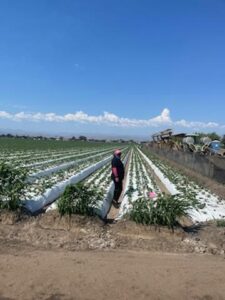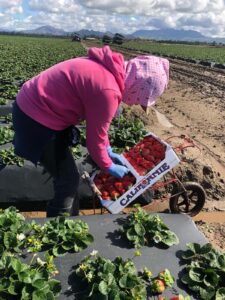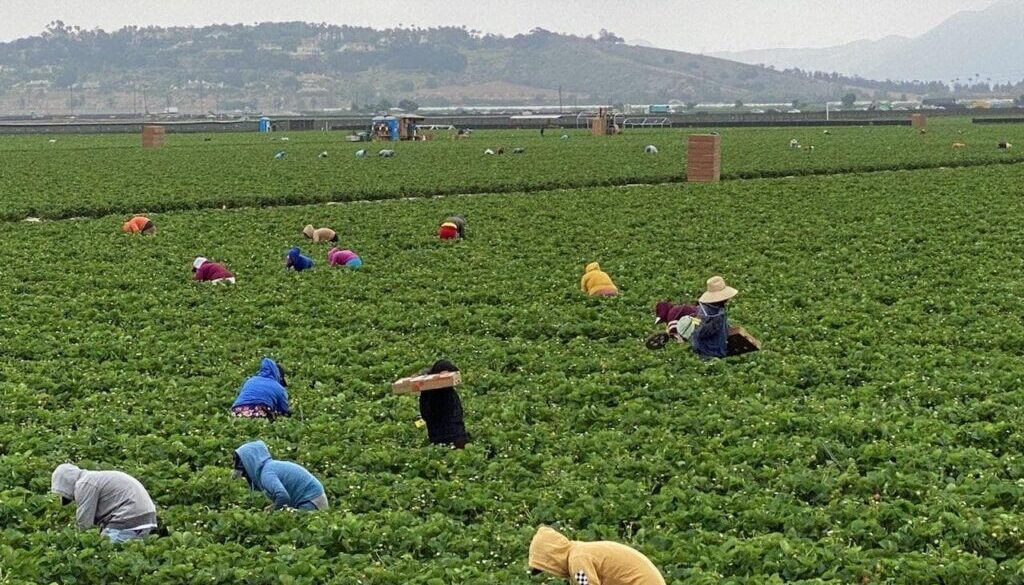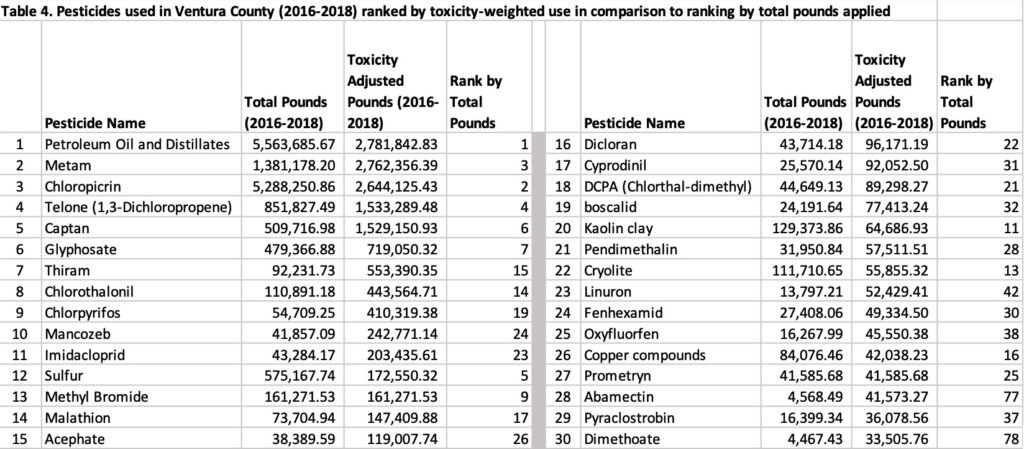Pesticides plague Californians of color, new study shows
Carmen Obeso was pulling weeds at a strawberry field in Ventura County, California when she smelled something strange. Nearby she spotted a machine spraying pesticides; soon, her eyes were watering and she felt sick to her stomach. Obeso, a Latina farmworker, reported the incident to her crew leader and was evaluated at an on-site health care clinic. A doctor there reassured her that she had not been exposed to anything harmful, and the company expected her back at work the following Monday.
But Obeso didn’t feel better by the next week, nor in the weeks that followed. Her eyes continued to water and felt gritty, and her vision was changing. She knew something was wrong, but the on-site physician still insisted she was fine. Finally, Obeso went to see a different doctor, who confirmed that her eyes had been affected.

Photo by Teresa Gomez.)
It has been two years since the spray incident, and Obeso said in a recent interview that her vision continues to worsen. She is almost blind in sunny conditions unless she wears shaded glasses, she said.
Now, instead of working in the fields, she volunteers with farmworker advocacy groups, and is one of a growing number of Hispanic/Latino farmworkers pushing for improved working conditions, including protections for pesticides.
“I feel there are other farmworkers in similar situations and they’re not able to voice it,” she said in Spanish during an interview aided by a translator. “When [the company] sprays the fields, they don’t put up postings. People go in and work and accumulate whatever was sprayed there. They might not always have acute reactions, but in the long run that’s when the consequences can be seen.”
Ventura County is known for its year-round production of roughly $2 billion worth of fruits and vegetables that feed people throughout the US and more than 70 other countries. Strawberries are the top crop, but workers also produce peppers, tomatoes, blueberries, avocados, and more.
But while these farms produce foods many consider staples of a healthy diet, the profusion of pesticides used on the fields pose significant risks to already vulnerable populations living and working in the area, according to research published this month in the journal Science of the Total Environment. These include thousands of mostly Latino farmworkers, many of which live below the poverty line and lack health insurance.
The study found that 17.1 million pounds of pesticides, or an average of 5.7 million pounds per year, were sprayed in Ventura County from 2016 to 2018. The pesticides used included more than 60 types known to be carcinogenic and 74 types linked to endocrine disruption. Another 85 pesticides used in the county were linked to developmental and reproductive toxicity.
In terms of volume, pesticides linked to cancer accounted for nearly a quarter of the total pounds of pesticides applied in the county, the researchers documented.
Notably, the study found that township sections where people of color were the majority had not just the most pesticide use, but also the most toxic pesticide use. More than half of the population in these areas was Latino or Hispanic. In contrast, areas that were relatively free of pesticides were overwhelmingly white communities.
The work adds to a growing body of research underscoring how communities of color face disproportionate exposure to pesticides and bear the brunt of adverse health impacts.
“Pesticide use is a known environmental justice issue,” said Alexis Temkin, a toxicologist at the Environmental Working Group (EWG) who helped lead the research. “But this study really adds a lot more data to show more specific impacts, potentially, on individual communities and individual areas.”
Monitoring the air
The researchers used sociodemographic data from the U.S. Census Bureau’s American Community Survey, layering over pesticide use data from 2016-2018 for Ventura County and then grouping together the most harmful types of pesticides.
The researchers highlighted two fumigants – metam potassium and sodium and 1,3-dichloropropene (1,3-D) – as examples of chemicals sprayed in the county that are both highly used and highly toxic.
The US Environmental Protection Agency (EPA) classified 1,3-D as “likely carcinogenic to humans” from 1985 to 2018, but in 2019 downgraded the classification to a “suggestive evidence of carcinogenic potential,” a decision that essentially allowed for expanded use and greater human exposure to the chemical often referred to by the trade name Telone. The EPA’s Office of Inspector General castigated the regulator for failing to properly consider cancer risks. But the EPA has not changed its position.

Anne Katten, pesticide safety specialist at the California Rural Legal Assistance Foundation (CRLAF), said the foundation has been calling on state officials to tighten restrictions on use of soil fumigants such as Telone. But the opposite has happened: while there used to be a cap on Telone use at 90,250 lbs per 36-square-mile area, the cap is now at 136,000 lbs.
DPR says it plans to propose Telone regulations later this fall and adds that it is developing a statewide pesticide notification system that will give the public advance notice about pesticide applications.
Air monitoring stations in Ventura County have detected high levels of Telone as well as a fumigant called chloropicrin, commonly used in producing strawberries, according to Katten. “Quite high levels” of chloropicrin were detected last year at an air monitoring station at a high school in the county, exceeding levels deemed safe by the California DPR, she said.
“It’s a problem for people working in the application of fumigants, but also people in nearby fields and people who live in the area are exposed to the drift,” she said.
The new study builds on work published in April in the journal BMC Public Health that examined how disparities in exposures and harms from pesticides impact disadvantaged communities in both rural and urban settings and how those disparities are perpetuated by a range of factors, including inadequate worker protections.
Concerns for children
As many as 500,000 children work as farmworkers in U.S. fields and orchards, according to the Association of Farmworker Opportunity Programs. But even children not in the fields still face significant risk from the agricultural chemicals, according to Bob Gunier, an environmental health scientist at the University of California, Berkeley. Gunier has spent more than a decade working on a birth cohort study of mostly Latino children born in the Salinas Valley, another coastal farmworker community.
“The strongest association we have seen between pesticide exposure during pregnancy and effects on children’s brains are with cognition, so like IQ and attention, ADHD,” said Gunier. “We have also looked at respiratory health, like asthma and lung function. For that, we actually see stronger associations [with exposure] during their childhood.”
California DPR adopted a regulation in 2018 creating a quarter-mile buffer zone for schools and daycares near fields that use pesticides, saying they are “working to improve grower field-level pesticide use reporting to more accurately track compliance with the school regulations.” But Gunier questions whether the measure is enough to protect communities, saying that pregnant women might be more sensitive and susceptible to pesticide exposure problems than other adults.
“If we really want to protect children’s health, we need to start there,” Gunier said.

Rosario Castañeda, a former Ventura County farmworker who has long suffered from a skin condition she developed while working in the fields, says she has seen many farmworker women suffer miscarriages. She believes they were caused by pesticide exposure.
“We see miscarriages happen a lot with women working in the field,” said Castañeda, who now works with a women’s farmworker advocacy organization called Lideres Campesinas. “Women who maybe don’t know they are pregnant and are exposed to dangerous pesticides end up having miscarriages.”
Avital Harari, an endocrine surgeon at the University of California, Los Angeles, is concerned about the role pesticide exposure might play in hormone function and cancer.
“We believe [pesticide exposure] can be both an endocrine disruptor, which can basically alter the hormone function of the thyroid, and potentially cause an increase in neoplasm, leading to thyroid cancer,” said Harari.
As Harari began researching risk factors for advanced thyroid cancer at UCLA, she noticed that a lot of her referrals were coming from Bakersfield in Kern County– one of the top agricultural counties in the U.S. In a recent case-control study using thyroid cancer cases from the California Cancer Registry, Harari and colleagues found that 10 of the 29 pesticides they analyzed were associated with thyroid cancer.
No voice, no vote
Despite scientific evidence for pesticide links to diseases and other health problems, many farmworkers are not aware of the extent of the risk they face, worker advocates say.
“On a daily basis, there are still immigrants coming to the U.S. that have no idea,” said Mily Trevino-Sauceda, executive director of the Alianza Nacional de Campesinas, which translates to the National Alliance of Farmworker Women.
However, those who have learned about pesticide health risks firsthand and managed to leave agricultural work behind are speaking out. And last month, hundreds of farmworkers made a 24-day, 335-mile march from Delano to Sacramento to urge California Gov. Gavin Newsom to sign a bill that would help enable farmworkers to unionize – an ability that would help empower them to fight back against pesticide exposure and other injustices.
“It’s more important for them to preserve the fruit than the wellbeing of the workers,” said Claudia Quezada, a former farmworker who now coordinates Lideres Campesinas’ projects in Oxnard. Quezada recalled that the company she used to work for would spray pesticides without regard for the weather. On humid mornings, when the chemicals would linger on the plants, the workers would sometimes develop rashes, she said.
Teresa Gomez, the Ventura County Community Organizer for Californians for Pesticide Reform, echoed the complaints, saying rashes and headaches are common among those working fields where pesticides are sprayed.
“We couldn’t complain… they would just tell us that we were being problematic and that we were just looking for a lawsuit,” said Gomez. “And so, we would just have to keep on working. Farmworkers don’t have a voice nor a vote and if they do speak up, they are threatened with being laid off or fired.”

Amadeo Sumano said he was fired from his job on a Ventura County farm after sharing a photo and a video on social media that showed pesticides being sprayed close to several farmworkers. He said his efforts to share the video have made it difficult for him to find other farm work in the area.
Nathan Donley, a researcher with the Center for Biological Diversity who was a co-author on the April study published in BMC Public Health, said the EPA needs to take several steps to better protect farmworkers, including establishing a national monitoring system to analyze the scope of harm they face just doing their jobs.
“I think it would be relatively easy for EPA under this administration to make some significant gains,” said Donley. “It would be nice to see this agency put the values of people over those of the pesticide industry.”
(Featured image by Amadeo Sudano.)






September 25, 2022 @ 12:43 pm
I wonder if more Americans would be concerned about the toxins we spray on our farmlands if they were told that about half of the “persons of color” affected were actually White. Hispanic is not a race, and about half of them living in the U.S. are Caucasian. The rest are mostly a mix of indigenous peoples and Whites. Once people realize that, will they demand that the government ban all the chemicals already banned in Europe? It may not completely solve the problem, but it would be a good start.
September 25, 2022 @ 8:27 am
Pesticides are horrendous and should be illegal
September 25, 2022 @ 2:09 am
I am extremely appalled that the government officials has permitted this form of genocide to knowingly happen.
September 24, 2022 @ 8:18 pm
the harms to agricultural workers are clear & present, as well as to children and the pregnant. The harms NOT listed go wider: pesticides are neurotoxins that will contribute to (if not cause) neurodegenerative diseases already simmering in the upscale communities downwind & downstream.
September 24, 2022 @ 5:41 pm
Thank you for your excellent work in producing this must read article. As a nurse I am acutely aware of the direct relationship between the health of our environment (water, air, soil) and the health of all who share the environment (humans, animals, plants, etc.). None of these components are disposable. May your reporting be part of the reasons more farmers move to regenerative and everyone becomes informed as we must all work to help each other.
September 24, 2022 @ 4:01 pm
Remove all pesticides
September 24, 2022 @ 3:45 pm
There is a major hospital near me and in the Oncology Department the nurse told me that there was a radiation leak coming from the chemo room. The nurse told me the nurses, technicians and physicians Dosimeters were all giving a false radiation reading of about zero mSv (millisieverts) of medical radiation when in fact their dosimeters were all defective or worse yet deliberately set to zero. In any case the Oncology physician (who was a British national working in the U.S.) contracted cancer and passed away from cancer at age 51. The staff are miserable and afraid. One nurse quit and left the U.S. medical profession and switched to playing guitar in Greenwich Village. Then 2 former OSHA representatives came to the hospital and warned everyone in the auditorium that the U.S. no longer has any occupational health protections. They explained that OSHA is in effect a farce. They went on to explain that in the U.S. whatever happens to workers health in the American workplace is the workers problem but that the worker can only hire his/her own private attorney to try and prove it in a U.S. court of law. The OSHA representatives said that in the U.S. the only thing OSHA can do is fine the corporation $3,400 even if the employee passed away as a result of corporate negligence or unsafe work conditions in that workplace and if the corporation contests the fine then the fine is raised to $5,000 and that is all. The employee’s family has no recourse without a private attorney. The U.S. has no consumer protection laws and no human rights laws. Those human rights laws exist in the European Union, Canada, Australia, New Zealand and the U.K. but not in the U.S. Read the World Democracy Index and the U.S. is not included as a full democracy. Quote: “The U.S. is presently not a functioning democracy” quotation by U.S. President (former) Jimmy Carter 2021
September 24, 2022 @ 2:30 pm
Why is anyone allowed to use pesticide that makes people sick and die?????
September 20, 2022 @ 8:07 pm
The same atrocities are happening in San Diego county, specifically in Oceanside’s protected prime farmland in South Morro Hills. There’s a farmworker housing community up the road from our home where lots of very scared workers live in housing provided by the farm owners for low rent. I’ve talked with a few of them out in the fields and they know the heavy pesticide use is awful, but they don’t have a voice in the matter. It’s either do the job or lose their job, their family’s home, and so much more. I’ve also talked with a few of the farm owners and their response is always “everything we do is legal and safe.” Meanwhile, through getting to know more of their family members who grew up and live in the area, I’ve learned that most of them have the same illnesses we know are linked to pesticides (parkinsons, alzheimers, dementia, RA, thyroid and immunity issues, cancer, infertility, etc.). They’re completely blind to the connection, even though several of them hold Phds in plant science from the state’s most respected universities. If they’re oblivious to their own family members’ suffering as a result of their pesticide use, these farm operators certainly are not aware of or concerned with the impacts to their farm workers. The only concern is for the 3 “P”s of commercial farming: Perfection. Profits. Pesticides.
The conversation about the dangers of pesticides must include solutions. And the solution is clear and proven. Many commercial farmers have made the move to Regenerative Agriculture and have discovered remarkable profits without pesticides, fungicides, or synthetic fertilizers. They’re regenerating the soil for healthier plants, healthier animals, healthier people, and a healthier Earth. As a business owner, it will be wise for growers to get onboard with the Regenerative Agriculture movement. Even if it’s just for profits at first, take one look at Google Trends for the “Regenerative Agriculture” topic… it’s taken off over the last 18 months and gaining the attention of investors and tech startups. If it wasn’t profitable, tech investors wouldn’t be after it.
September 28, 2022 @ 2:43 pm
a greedy man never knows what he has done (“they are completely blind to the connection…”)
vulture-capitalism. the ‘chemi$t$’/mon$atan, et al, $erve greed/de$truction.
fentanyl has nothing on greed.
mr russel, 100 years ago:
“i’ve studied man for 9 decades now,
and have changed my conclusion–
what he loves-most is not greed,
he loves-most destruction”
votevotevote